Pup Development- Week One
Shortly after the birth you should check the litter. Count the babies and remove any stillborns. Make sure that any cloth used for nesting does not have strings or holes that could cause injury to the neonate rat.
Some mother rats are very protective and may bite, particularly in the first week after birth.
If you are not sure of the mother’s response to your intrusion into her nest you may want to remove her. This can be done by luring her out with a snack. If your mother is nervous, make the check quickly. There is no reason to handle the babies much in their first few days or even the first week of life other than to make sure they are thriving.
After the babies are a few days old you can clean out the birth cage. If the cage was cleaned shortly before birth and/or the birth was not bloody, you may be able to wait a few more days.
Check to make sure all babies are removed before you clean. This will prevent any babies from accidentally being thrown away with the bedding. You may want to return the “nest house” as well as some of the cleaner nesting material to the newly cleaned cage. This may help to alleviate maternal stress.
Days 1-7
| When they are first born the babies do not have many features that make them look like rats. They have no fur, only slight whiskers and their eyelids are sealed. Their eyes can only be seen as dark spots beneath the skin. You can tell within the first few days if the eyes are pink or black, but it is hard to distinguish between ruby and black. | 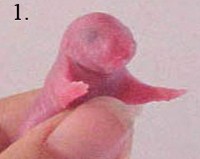 |
| The ears are small buds that lay flattened against the head, the ear canals are sealed. Even though the babies are very vocal they cannot yet hear. the pup’s limbs, fingers, toes, and tail are not yet developed.
Shortly after birth you can distinguish whether or not the babies are rex by checking to see if the whiskers are straight or curly. |
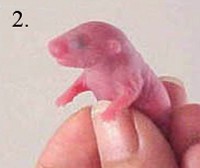 |
| In photo of day 3 you can see the milk through the thin skin of the stomach. Occasional checks can be made to ensure that the mother is feeding the babies sufficient amounts, especially in a large litter. |
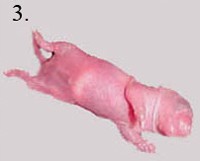 |
| By day 4 the beginning of colors and patterns are showing. The ears are slowly developing. An experienced breeder may be able to tell whether the ears are standard or dumbo. This pup is a dumbo. It can’t yet be determined what his color is although he seems to be a Berkshire or a self. | 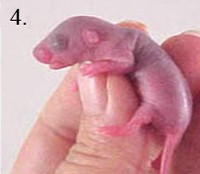 |
| The babies get more active as the first week progresses. All of their needs at this age are supplied by the mother. She feeds them, cleans them, stimulates them to urinate and have bowel movements, keeps them warm, and protects them. | 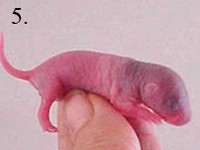 |
| Although still quite small, the babies become more active with each passing day, (as you can see in photo 6, photographing them becomes a bit tricky).
The ears start to protrude more; the fingers and toes are lengthening |
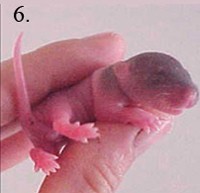 |
| In the day 7 photo slight fuzz can be seen on this pup. He is an agouti capped pup with a tiny head spot. Notice that the facial features at the end of the first week have finally become more prominent.
Sex is determined by comparing the distance between the pup’s genitals and anus. |
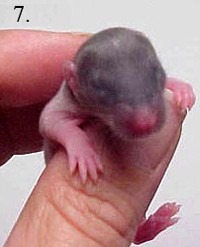 |
Photos by Joanne “Bella” Hodges


